torque CHEVROLET MALIBU 2004 5.G Owners Manual
[x] Cancel search | Manufacturer: CHEVROLET, Model Year: 2004, Model line: MALIBU, Model: CHEVROLET MALIBU 2004 5.GPages: 426, PDF Size: 3.98 MB
Page 99 of 426
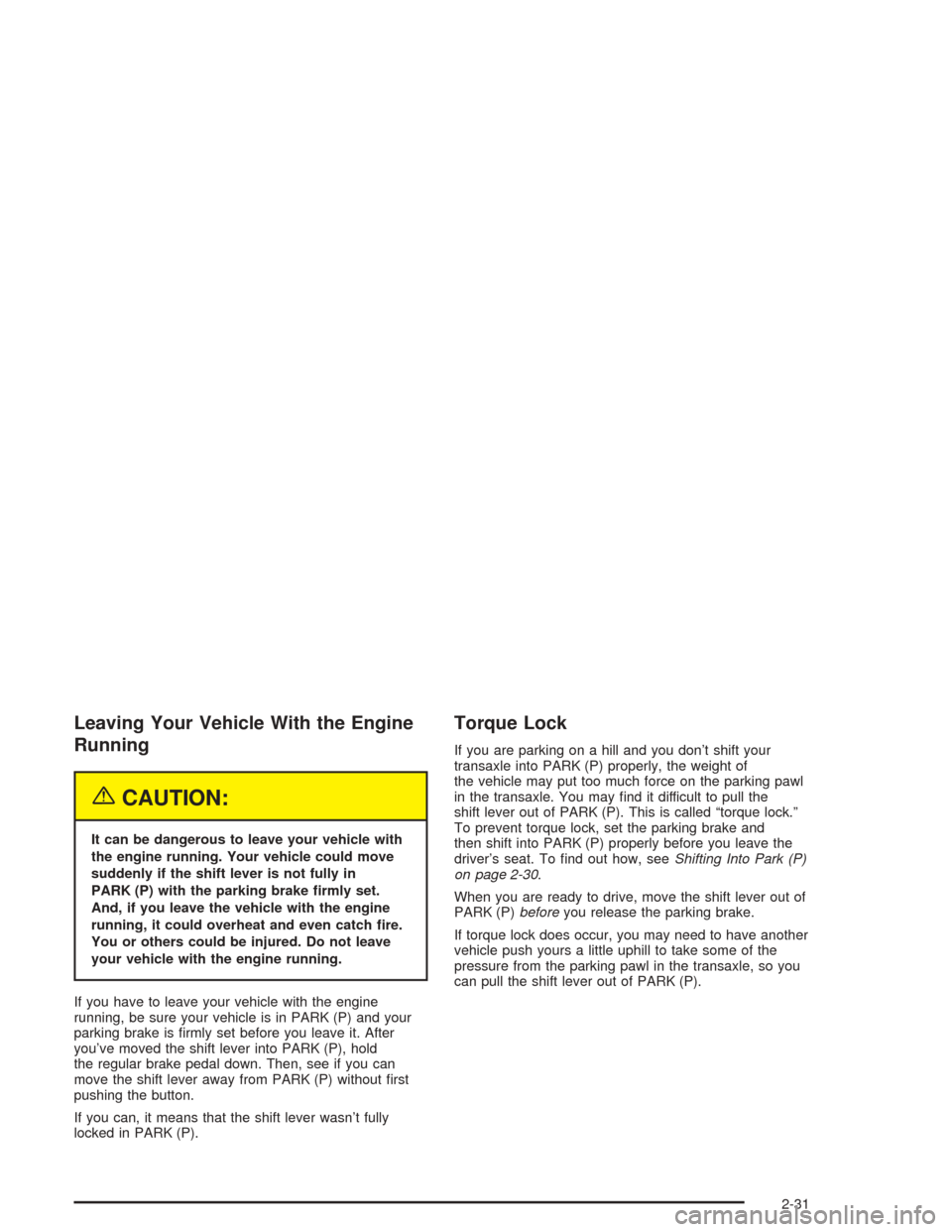
Leaving Your Vehicle With the Engine
Running
{CAUTION:
It can be dangerous to leave your vehicle with
the engine running. Your vehicle could move
suddenly if the shift lever is not fully in
PARK (P) with the parking brake �rmly set.
And, if you leave the vehicle with the engine
running, it could overheat and even catch �re.
You or others could be injured. Do not leave
your vehicle with the engine running.
If you have to leave your vehicle with the engine
running, be sure your vehicle is in PARK (P) and your
parking brake is �rmly set before you leave it. After
you’ve moved the shift lever into PARK (P), hold
the regular brake pedal down. Then, see if you can
move the shift lever away from PARK (P) without �rst
pushing the button.
If you can, it means that the shift lever wasn’t fully
locked in PARK (P).
Torque Lock
If you are parking on a hill and you don’t shift your
transaxle into PARK (P) properly, the weight of
the vehicle may put too much force on the parking pawl
in the transaxle. You may �nd it difficult to pull the
shift lever out of PARK (P). This is called “torque lock.”
To prevent torque lock, set the parking brake and
then shift into PARK (P) properly before you leave the
driver’s seat. To �nd out how, seeShifting Into Park (P)
on page 2-30.
When you are ready to drive, move the shift lever out of
PARK (P)beforeyou release the parking brake.
If torque lock does occur, you may need to have another
vehicle push yours a little uphill to take some of the
pressure from the parking pawl in the transaxle, so you
can pull the shift lever out of PARK (P).
2-31
Page 319 of 426
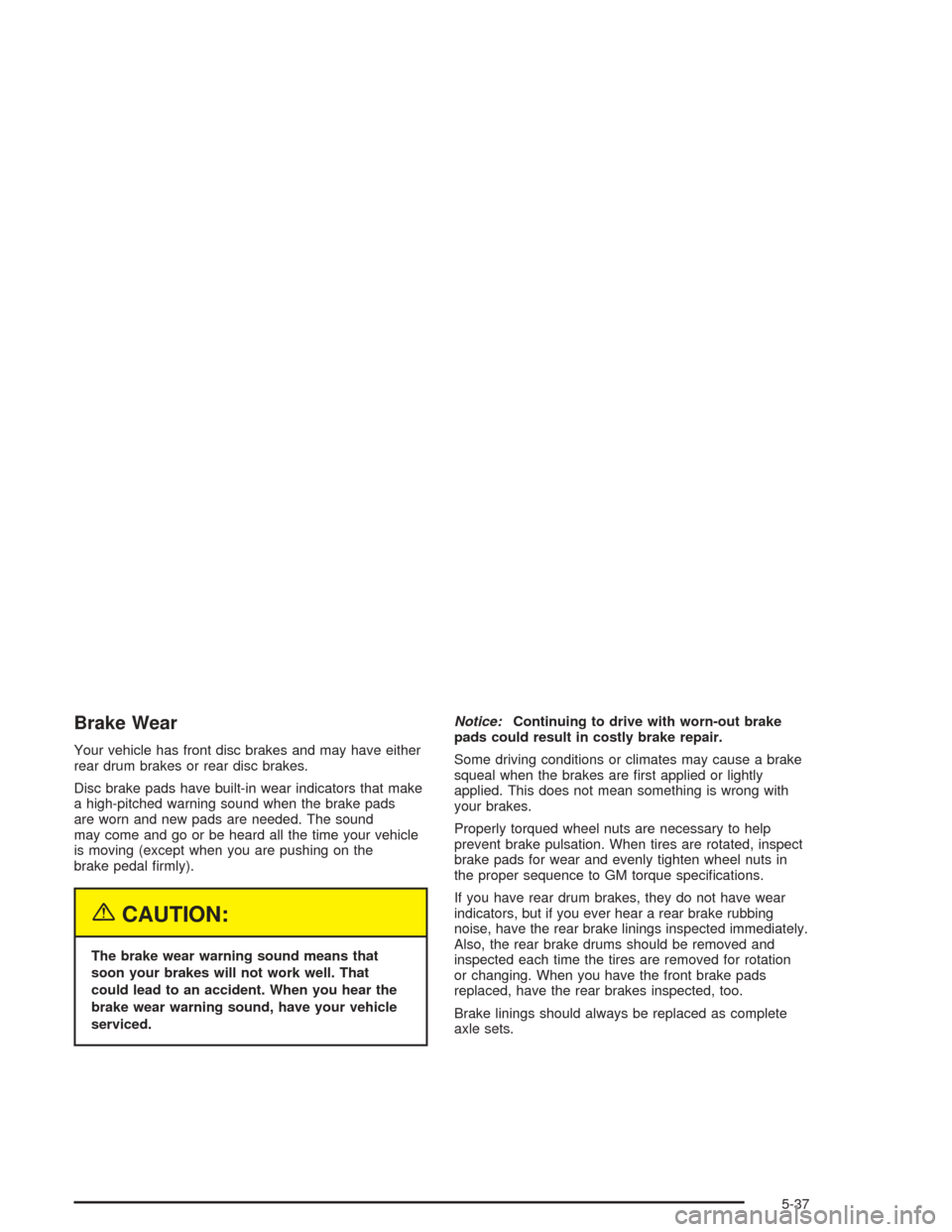
Brake Wear
Your vehicle has front disc brakes and may have either
rear drum brakes or rear disc brakes.
Disc brake pads have built-in wear indicators that make
a high-pitched warning sound when the brake pads
are worn and new pads are needed. The sound
may come and go or be heard all the time your vehicle
is moving (except when you are pushing on the
brake pedal �rmly).
{CAUTION:
The brake wear warning sound means that
soon your brakes will not work well. That
could lead to an accident. When you hear the
brake wear warning sound, have your vehicle
serviced.Notice:Continuing to drive with worn-out brake
pads could result in costly brake repair.
Some driving conditions or climates may cause a brake
squeal when the brakes are �rst applied or lightly
applied. This does not mean something is wrong with
your brakes.
Properly torqued wheel nuts are necessary to help
prevent brake pulsation. When tires are rotated, inspect
brake pads for wear and evenly tighten wheel nuts in
the proper sequence to GM torque speci�cations.
If you have rear drum brakes, they do not have wear
indicators, but if you ever hear a rear brake rubbing
noise, have the rear brake linings inspected immediately.
Also, the rear brake drums should be removed and
inspected each time the tires are removed for rotation
or changing. When you have the front brake pads
replaced, have the rear brakes inspected, too.
Brake linings should always be replaced as complete
axle sets.
5-37
Page 341 of 426

Don’t include the compact spare tire in your tire rotation.
After the tires have been rotated, adjust the front and
rear in�ation pressures as shown on the Tire and
Loading Information label. Make certain that all wheel
nuts are properly tightened. See “Wheel Nut Torque”
underCapacities and Speci�cations on page 5-96.
{CAUTION:
Rust or dirt on a wheel, or on the parts to
which it is fastened, can make wheel nuts
become loose after a time. The wheel could
come off and cause an accident. When you
change a wheel, remove any rust or dirt from
places where the wheel attaches to the vehicle.
In an emergency, you can use a cloth or a
paper towel to do this; but be sure to use a
scraper or wire brush later, if you need to,
to get all the rust or dirt off. See “Changing a
Flat Tire” in the Index.
When It Is Time for New Tires
One way to tell when
it’s time for new tires
is to check the treadwear
indicators, which will
appear when your
tires have only
1/16 inch (1.6 mm) or
less of tread remaining.
You need a new tire if any of the following statements
are true:
You can see the indicators at three or more places
around the tire.
You can see cord or fabric showing through the
tire’s rubber.
The tread or sidewall is cracked, cut or snagged
deep enough to show cord or fabric.
The tire has a bump, bulge or split.
The tire has a puncture, cut or other damage
that can’t be repaired well because of the size
or location of the damage.
5-59
Page 355 of 426
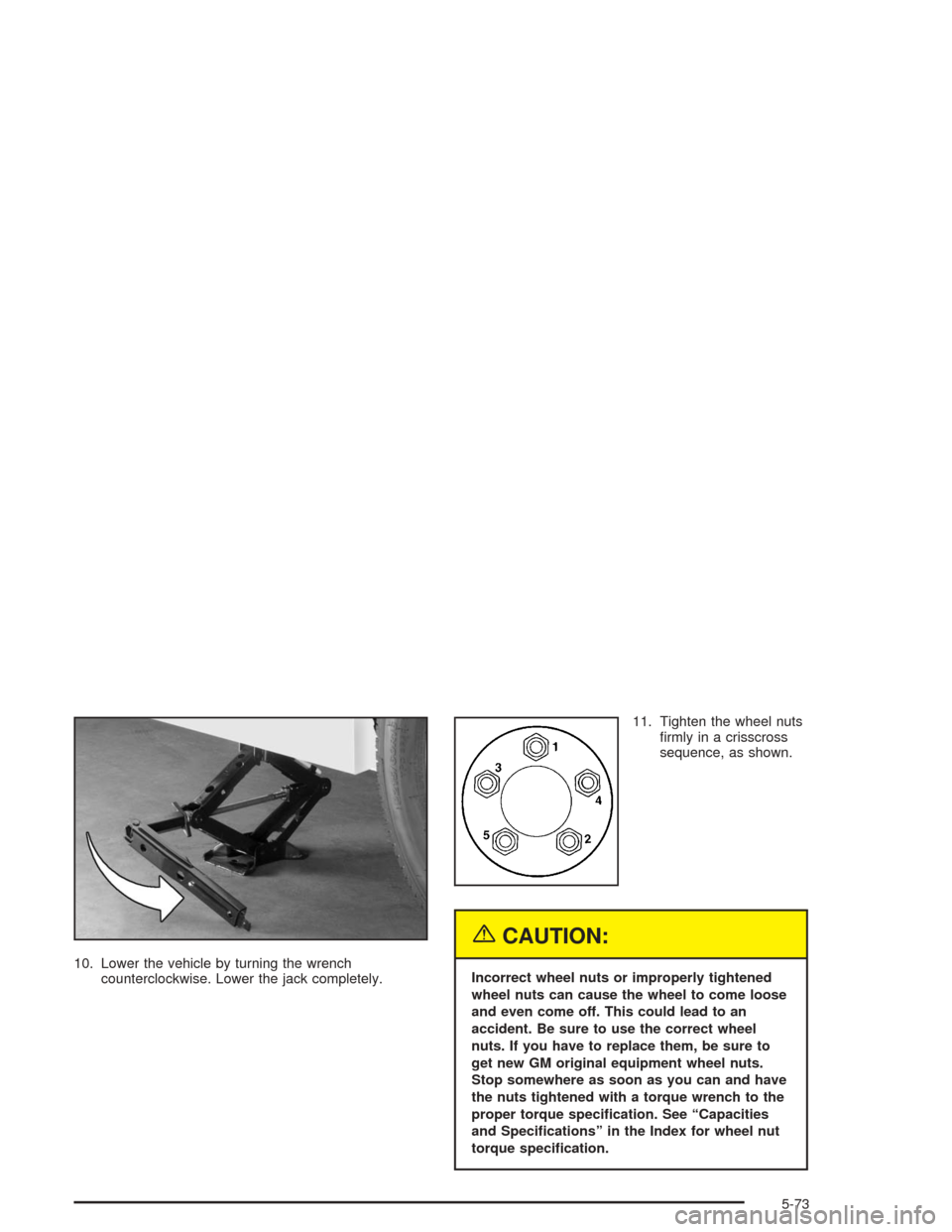
10. Lower the vehicle by turning the wrench
counterclockwise. Lower the jack completely.11. Tighten the wheel nuts
�rmly in a crisscross
sequence, as shown.
{CAUTION:
Incorrect wheel nuts or improperly tightened
wheel nuts can cause the wheel to come loose
and even come off. This could lead to an
accident. Be sure to use the correct wheel
nuts. If you have to replace them, be sure to
get new GM original equipment wheel nuts.
Stop somewhere as soon as you can and have
the nuts tightened with a torque wrench to the
proper torque speci�cation. See “Capacities
and Speci�cations” in the Index for wheel nut
torque speci�cation.
5-73
Page 356 of 426
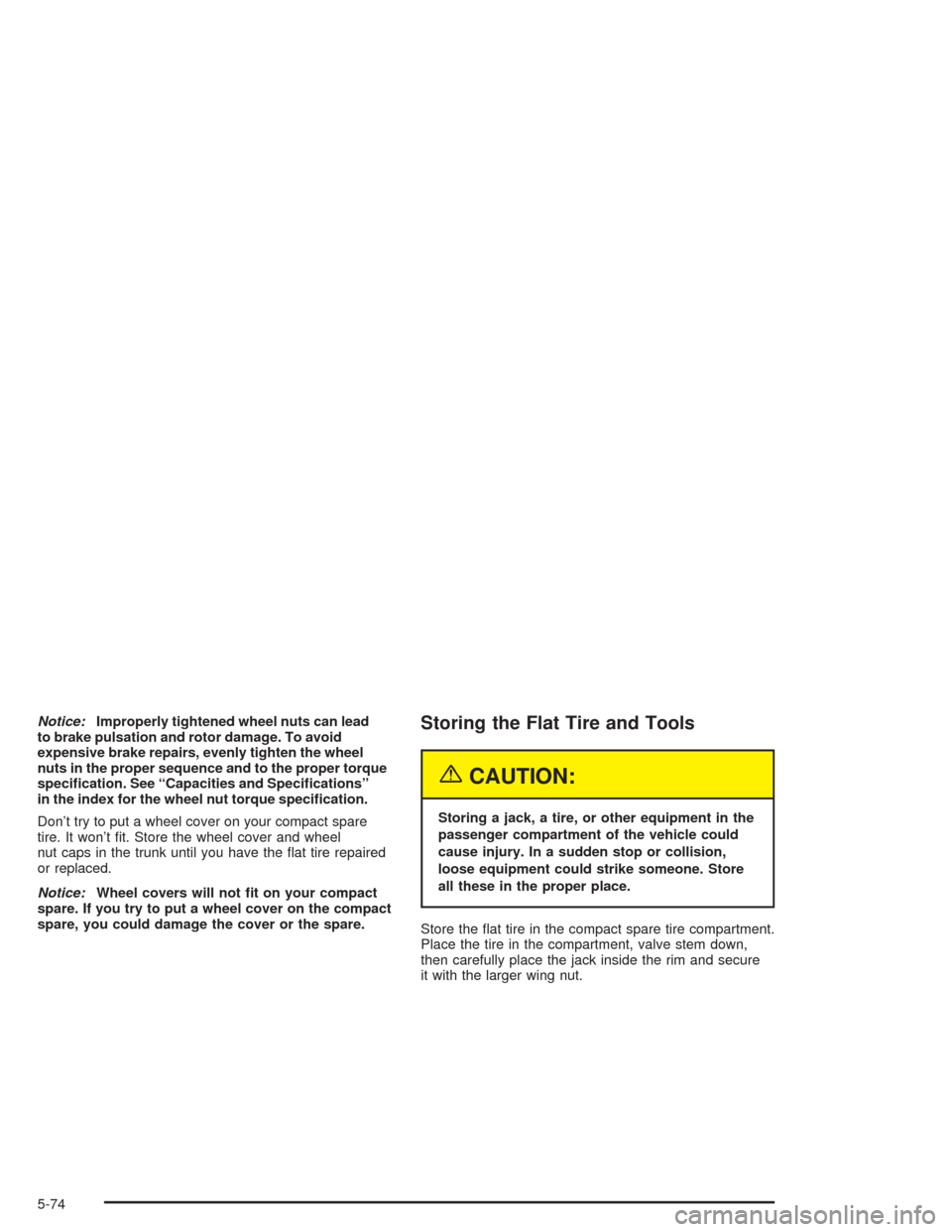
Notice:Improperly tightened wheel nuts can lead
to brake pulsation and rotor damage. To avoid
expensive brake repairs, evenly tighten the wheel
nuts in the proper sequence and to the proper torque
speci�cation. See “Capacities and Speci�cations”
in the index for the wheel nut torque speci�cation.
Don’t try to put a wheel cover on your compact spare
tire. It won’t �t. Store the wheel cover and wheel
nut caps in the trunk until you have the �at tire repaired
or replaced.
Notice:Wheel covers will not �t on your compact
spare. If you try to put a wheel cover on the compact
spare, you could damage the cover or the spare.Storing the Flat Tire and Tools
{CAUTION:
Storing a jack, a tire, or other equipment in the
passenger compartment of the vehicle could
cause injury. In a sudden stop or collision,
loose equipment could strike someone. Store
all these in the proper place.
Store the �at tire in the compact spare tire compartment.
Place the tire in the compartment, valve stem down,
then carefully place the jack inside the rim and secure
it with the larger wing nut.
5-74
Page 378 of 426
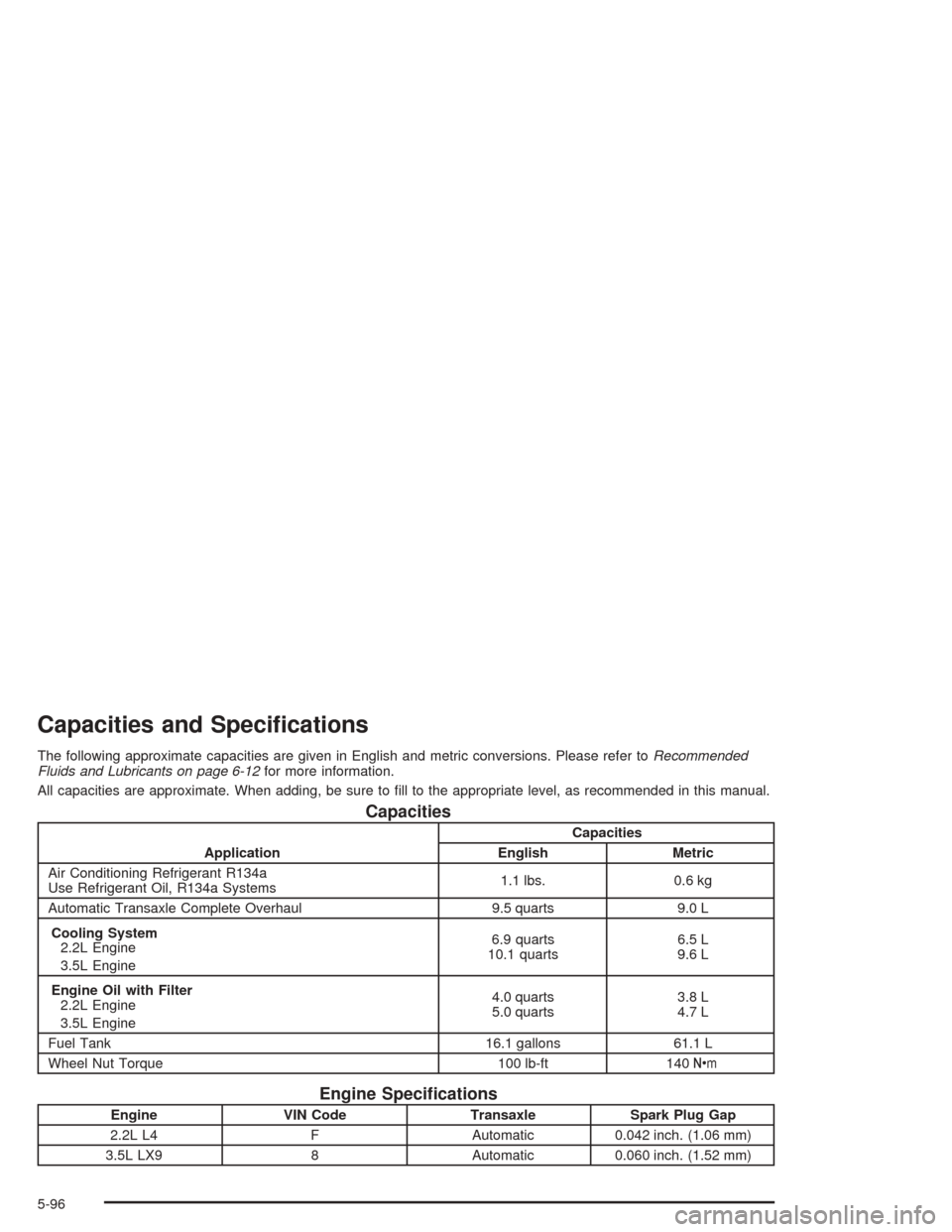
Capacities and Speci�cations
The following approximate capacities are given in English and metric conversions. Please refer toRecommended
Fluids and Lubricants on page 6-12for more information.
All capacities are approximate. When adding, be sure to �ll to the appropriate level, as recommended in this manual.
Capacities
ApplicationCapacities
English Metric
Air Conditioning Refrigerant R134a
Use Refrigerant Oil, R134a Systems1.1 lbs. 0.6 kg
Automatic Transaxle Complete Overhaul 9.5 quarts 9.0 L
Cooling System
2.2L Engine
3.5L Engine6.9 quarts
10.1 quarts6.5 L
9.6 L
Engine Oil with Filter
2.2L Engine
3.5L Engine4.0 quarts
5.0 quarts3.8 L
4.7 L
Fuel Tank 16.1 gallons 61.1 L
Wheel Nut Torque 100 lb-ft 140Y
Engine Speci�cations
Engine VIN Code Transaxle Spark Plug Gap
2.2L L4 F Automatic 0.042 inch. (1.06 mm)
3.5L LX9 8 Automatic 0.060 inch. (1.52 mm)
5-96
Page 424 of 426

Theft-Deterrent, Radio....................................3-115
Theft-Deterrent Systems...................................2-18
Content Theft-Deterrent................................2-18
PASS-Key
®III+...........................................2-20
PASS-Key®III+ Operation.............................2-20
Throttle, Adjustable..........................................2-24
Tilt Wheel........................................................ 3-7
Tips and Trouble...........................................3-108
Tire Changing Tools........................................5-67
Tire In�ation Check........................................... 6-9
Tire Sidewall Labeling......................................5-50
Tire Size.......................................................5-54
Tire Terminology and De�nitions........................5-55
Tires.............................................................5-50
Buying New Tires........................................5-60
Chains.......................................................5-64
Changing a Flat Tire....................................5-66
Compact Spare Tire.....................................5-77
If a Tire Goes Flat.......................................5-65
In�ation - Tire Pressure................................5-57
Inspection and Rotation................................5-58
Uniform Tire Quality Grading.........................5-61
Wheel Alignment and Tire Balance.................5-62
Wheel Replacement.....................................5-62
When It Is Time for New Tires......................5-59
To Use the Engine Coolant Heater....................2-26Top Strap......................................................1-42
Top Strap Anchor Location...............................1-43
Torque Lock...................................................2-31
Total Weight on Your Vehicle’s Tires..................4-43
Towing
Recreational Vehicle.....................................4-31
Towing a Trailer..........................................4-40
Your Vehicle...............................................4-31
Traction
Enhanced Traction System (ETS).................... 4-9
Enhanced Traction System (ETS) Active Light....3-38
Enhanced Traction System (ETS) Warning
Light......................................................3-37
Trailer Brakes.................................................4-43
Transaxle
Fluid, Automatic...........................................5-23
Transaxle Operation, Automatic.........................2-27
Transmission, Transaxle, Transfer Case Unit
Repair Manual............................................7-12
Transportation Options...................................... 7-8
Trip Odometer................................................3-33
Trunk............................................................2-13
Trunk Lamp...................................................3-19
Turn and Lane-Change Signals.......................... 3-8
Turn Signal/Multifunction Lever........................... 3-8
Turn Signals When Towing a Trailer..................4-45
14